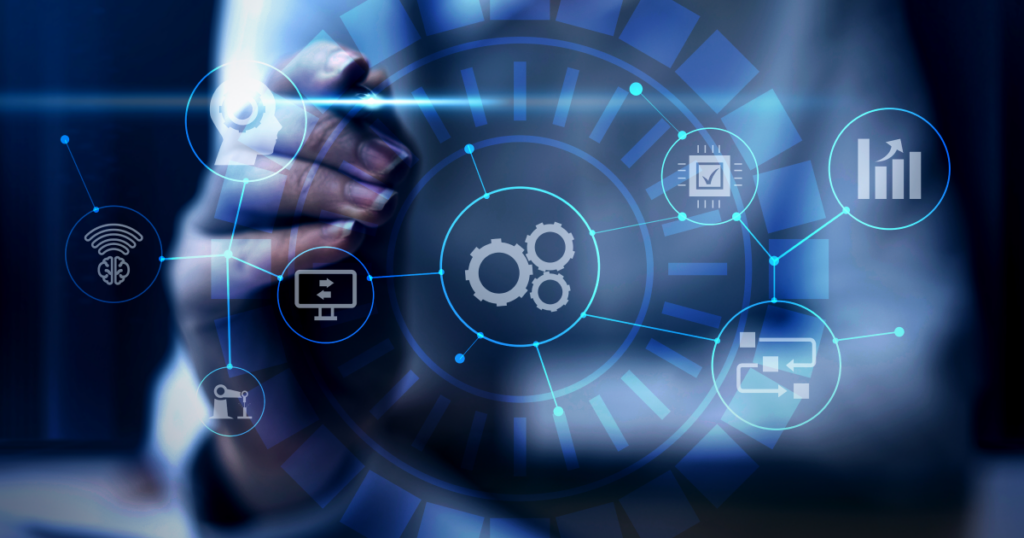Download Your Comprehensive Toolkit Guide
Is email marketing still relevant in the age of instant messaging and social media?
What if we told you that in 2022, there were 4.26 billion global email users, and this number is expected to reach 4.73 billion by 2026?
Despite the rise of new communication platforms, email remains as vibrant and relevant as ever.
51% of businesses spending $500+ monthly report an ROI of $31 or more for every dollar spent.
Email marketing is a time-tested and proven strategy for reaching and engaging your target audience. However, the way we do email marketing is changing, thanks to the rise of artificial intelligence (AI).
The question is: Is your email marketing ready for a transformation to engage more customers? Our email marketing agency is here to give you the answers!
Evolution of Email Marketing

Traditionally, email marketers have relied on a one-size-fits-all approach. They would send the same email to everyone on their list, regardless of their interests or needs. This approach is no longer effective.
AI in email marketing uses data and algorithms to personalize each email for each recipient. This results in higher open rates, click-through rates, and conversions.
In today’s dynamic marketing landscape, AI is essential for businesses that want to succeed. AI can help companies stay ahead of the curve by providing the tools and insights they need to create and execute more effective marketing campaigns.
In this comprehensive guide, we will explore the transition from traditional to AI-driven email marketing, highlighting the benefits and providing a roadmap for implementation.
We will define AI-driven email marketing and explain its advantages, including increased open rates, click-through rates, conversions, customer engagement, and ROI.
By the end of this guide, you will understand AI email marketing and how to use it to grow your business.
The Fundamentals of AI-Driven Email Marketing

Let’s start by demystifying AI. It’s the ability of a machine to simulate human intelligence.
You can use AI to automate tasks, make predictions, and learn from data. Now, it’s shaking up marketing in a big way.
How can AI Transform Email Marketing?
AI transforms email marketing from generic blasts to personalized, strategic interactions. Your audience feels heard, and your business benefits.
AI can transform email marketing by helping businesses to:
- Send more personalized emails: AI can segment email lists and send more personalized emails to each segment. Personalization is so important that 35% of companies deploying AI use it to create more personalized experiences.
- Automate email marketing tasks: AI can automate many routine email marketing tasks, such as sending welcome emails, abandoned cart emails, and birthday emails.
- Gain insights into email marketing performance: AI can track the results of email marketing campaigns and identify areas for improvement.
- Send emails on time: AI can tell you the best time to send your emails, increasing the open rates.
- Craft engaging subject lines: AI generates attention-grabbing subject lines tailored to the preferences of your recipients by analyzing vast amounts of data (including what subject lines have worked in the past).
The Role of Machine Learning: AI’s Companion in Smart Email Marketing
Artificial intelligence (AI) and machine learning (ML) are two closely related fields, but they are not the same thing.
AI is a broad term that refers to the ability of machines to simulate human intelligence. ML is a subset of AI that focuses on developing algorithms that can learn from data and improve performance over time.
In email marketing, AI can personalize messages, automate tasks, and gain insights into customer behavior. ML can train AI models to perform these tasks more effectively.
How Machine Learning Complements AI in Email Campaigns?
ML complements AI in email campaigns by providing a way to train AI models on customer data. This allows AI models to learn from past customer interactions and improve performance.
An AI-powered email marketing platform can use ML to train a model to predict which customers are most likely to open and click on a particular email. This information can then be used to send more targeted emails to each customer.
For instance, Netflix uses machine learning to personalize its email subject lines and content.
Netflix analyzes customer data factors such as viewing history, preferences, and device type to determine which email subject lines and content are most likely relevant to each customer. Netflix then uses this information to send more targeted emails to each customer.
Ensuring Readability and Engagement: Crafting Compelling Emails
Let’s say you’ve crafted an enticing subject line that draws your audience in. They’ve opened your email. Now what?
Ensuring your email is not just readable but also engaging is the next crucial step in your email marketing journey.
But engagement doesn’t stop at readability. It’s about sparking interest and interaction. AI can help you analyze what content your audience prefers, such as images, videos, or interactive elements.
With this knowledge, you can craft emails that resonate with your readers.
Here are 5 techniques to enhance email engagement through the power of AI:
- Personalize email content: Universal emails don’t engage many customers. AI can dive deep into your data, learning what your subscribers love and tailoring your emails accordingly.
- Dynamic Content Delights: AI can make your emails come alive with dynamic content. Imagine sending an email with product recommendations that change based on what your subscribers have been browsing on your website.
- Segment email lists: AI can segment email lists based on customer behavior patterns. This can improve engagement.
- Timing Is Everything: AI knows the best times to send your emails. It can analyze when your subscribers are most active and ensure your emails land in their inbox at the right moment.
- Optimize email subject lines: AI can craft irresistible subject lines. It knows what works and what doesn’t. So, your emails won’t just sit in the inbox.
Tools to Measure and Improve Readability and Engagement
- Readability Checkers: These tools analyze your text and give you a score based on how easy it is to read. Some popular readability checkers include Readable, Grammarly, and Hemingway Editor.
- Email Marketing Analytics Tools: These software solutions monitor the effectiveness of your email campaigns, encompassing metrics such as open rates, click-through rates, and conversions. This data aids in pinpointing areas for enhancing the clarity and engagement of your emails. Some prominent email marketing analytics tools are Campaign Monitor, Mailchimp, and Inbox Analyzer.
- Email testing tools: These tools allow you to assess how your emails appear and function across various email clients and devices, ensuring they maintain their intended appearance and functionality. Some popular email testing tools include Mailtrap, Moosend, and Litmus.
Strategies to Improve Email Engagement
AI is a game changer in email marketing, but it doesn’t matter that it doesn’t need human touch.
Here are some strategies you can use to improve the engagement of your emails.
- Use short sentences and paragraphs: Long sentences and sections can be difficult to read, especially on mobile devices. Aim to keep your sentences to 20 words or less and your paragraphs to two or three sentences.
- Use simple language: Avoid using jargon and technical terms that your audience may not understand. If you use technical terms, ensure to define them clearly.
- Use an active voice: Active voice is more concise and accessible to read than passive voice. For example, instead of saying, “The product was launched by our team,” say, “Our team launched the product.”
- Use transition words: Transition words make it easier for readers to follow your writing and see how different ideas are connected. Some common transition words include “however,” “therefore,” and “moreover.”
- Use visuals: Images and videos can make your text more appealing and engaging. However, use visuals sparingly, as too many can be distracting.
- Optimize your email subject lines: Your email subject line is the first thing people see, so it’s essential to make it attention-grabbing and relevant. Keep your subject lines short (no more than 60 characters) and to the point, and use keywords that your audience is likely to be searching for.
- Test and optimize your campaigns: Once you’ve sent your email campaign, monitor the results and identify areas where you can improve.
Optimizing Content with AI: Elevating Your Message

Now, let’s dive into how AI takes your content to the next level, making it resonate with your audience like never before.
Tell you a secret: you’re not the only one sending emails to your subscribers. They get hundreds of emails from all sides. That’s why you must personalize your content to stand out and convey to your subscribers: “You’re valued.”
In 2022, more than 60% of online shoppers who participated in a survey indicated that brands not offering personalized content would risk losing their loyalty.
Remember, your subscribers want content that speaks to them personally.
How AI Enables Personalization at a Mass Scale?
AI can help you to personalize content at scale. AI can analyze customer data and identify patterns and trends.
This information can then be used to create personalized content tailored to the individual needs and interests of each customer.
For instance, if you run an online store, AI can suggest products similar to ones your customers have previously purchased or offer exclusive discounts based on their preferences.
Strategies for Implementing Personalized Content
But wait, there needs to be more than the recipient’s name to reach personalized content.
Here are five strategies:
- Use AI to Gather Comprehensive Customer Data: AI can dig deep into the data vault and provide insights that you might not even know you have. It uncovers valuable information, from past purchases to browsing habits, helping you understand your customers on a whole new level.
- Leverage AI-Driven Segmentation: AI analyzes customer data and identifies patterns you might miss. This helps create precise segments that ensure your email content hits the mark.
- Deploy AI for Triggered Emails: AI doesn’t just automate your emails; it personalizes them based on real-time customer behavior. If a customer abandons their shopping cart, AI can send a personalized email with product recommendations, returning them to complete the purchase.
- AI-Powered Personalization Across the Customer Journey: Online customers have a journey from discovery to purchase. Personalized messages guide them. At the start, it’s about incentives and suggesting related items. If they add to their cart but don’t buy, AI helps with reminders and turning them into loyal customers.
- Extend AI-Driven Personalization Beyond Email: AI isn’t limited to email marketing; it’s your personalization powerhouse across all channels. Whether it’s your website, social media, or mobile app, AI ensures your customers feel the love and relevance everywhere they interact with your brand.
Download Your Comprehensive Toolkit Guide
Dynamic Content and A/B Testing: Constantly Improving
In email marketing, staying ahead means staying dynamic. It’s all about creating emails that adapt to your audience and using data to fine-tune your strategies.
That’s where dynamic content and A/B testing come into play.
Dynamic content is tailoring your content to each recipient’s unique characteristics and interests. This can include their name, location, purchase history, browsing behavior, and more.
Dynamic content can supercharge your email campaigns in several ways. For instance, you can use it to:
- Include the recipient’s name in the subject line and email body, making the email more personal.
- Recommend products or services based on the recipient’s previous purchase history, showing them you understand their preferences and offering relevant options.
- Send various options of an email campaign to multiple segments of your email list, ensuring that each group receives content that resonates with them.
How AI Streamlines A/B Testing?
A/B testing is experimenting with two versions of a variable to see which one performs better. In email marketing, you can use A/B testing to compare subject lines, content, images, and calls to action.
AI automates this process and crunches the numbers to tell you which version wins. This helps you fine-tune your email content and design for maximum impact.
Language and Tone: Adapting to Your Audience
Language and tone are essential to any communication, but they are especially critical in email marketing.
The correct language and tone can help you build relationships with your audience, drive engagement, and boost conversions.
If you use the wrong language or tone, you could damage your reputation and even lose customers.
AI can help you to analyze and adapt your email tone.
AI is like your email’s emotional intelligence. It can analyze the words you use and the overall tone of your email to ensure it aligns with your audience’s preferences.
Enhancing Deliverability with AI: Ensuring Customers See Your Emails

It’s crucial to ensure that your emails get seen by your target audience.
AI can help you to achieve this by enhancing your deliverability.
Inbox Placement Strategies: Avoiding the spam folder
Inbox placement is a vital email marketing metric. It measures the percentage of emails that successfully reach the recipient’s inbox instead of the spam folder.
Several factors come into play when it comes to achieving favorable inbox placement, including:
Sender Reputation: Email service providers (ESPs) keep a close eye on the sender’s reputation. They assess various parameters like bounce rates, spam complaints, and recipient engagement to estimate a sender’s trustworthiness.
Email Content: ESPs employ sophisticated algorithms to analyze email content for spam indicators, such as spammy keywords, excessive use of capital letters, or an abundance of exclamation points.
List Hygiene: Maintaining a clean and updated email list is essential. This involves regularly removing inactive subscribers and invalid email addresses, ensuring your list remains high-quality.
Here’s what AI can do to enhance inbox placement:
- Monitor your email subject lines and spot the ones with a higher chance of getting opened.
- Tailor your email content according to each recipient’s preference and past buying habits.
- Assist in recognizing and eliminating dormant subscribers from your email list.
- Monitor your email metrics like open rates, click-through rates, and unsubscribe rates.
Tools for Ensuring Deliverability
AI tools and industry best practices work hand in hand to keep your emails in the inbox.
Here are five tools that enable you to assess and enhance your email deliverability:
Personalization and Segmentation with AI: Crafting Unique Journeys

Now, let’s dive into personalization and segmentation, where AI becomes your trusty guide in creating unique email journeys.
Understanding Your Audience: Building Detailed Customer Profiles:
A customer profile is like a detailed map of a customer perfectly matching your brand.
It takes a lot of work to gather all this information manually. So AI can help you.
It collects this information from potential customers’ buying history, interactions on the website, engagement with marketing campaigns, and social media or survey activity.
Just like Amazon uses AI to analyze customer purchase history and browsing behavior to recommend relevant products and services.
Email Segmentation Strategies: Tailoring Content to Different Audience Segments
Email segmentation means sorting your email subscribers into different groups based on age, location, and what they do. It’s different from personalization, which customizes emails for each person.
With segmentation, you create groups of similar people to send them more focused emails.
For example, if you provide software services, you might have segments for web developers and marketing professionals.
The smaller your segments, the more personalized you can make your emails, and this can attract more customers to your website.
Here are AI-driven techniques for effective segmentation:
- Behavior-Based Segmentation: AI can analyze the actions and behaviors of your email subscribers, allowing you to create segments based on what they click on, their browsing history, and more.
- Predictive Analytics: With AI, you can anticipate what products or services a subscriber might be interested in, using their previous actions and preferences as clues.
- Natural Language Processing (NLP): AI-powered NLP can analyze the content of subscriber interactions, such as emails or chatbot conversations, to understand their interests and needs.
- Clustering Algorithms: AI can group subscribers with similar characteristics or behaviors, creating segments automatically.
- Dynamic Segmentation: AI can update segments in real-time based on the latest subscriber data, ensuring your emails remain relevant.
- Churn Prediction: AI can identify subscribers at risk of unsubscribing, allowing you to target them with retention strategies.
Many startups and small businesses wonder about the power of triggers, especially behavioral triggers.
Simply put, triggers are the rules or conditions that kickstart your automation.
They can be used in email, social media, on your website, or anywhere you want to automate a process.
Behavioral triggers are all about actions your users take, such as page views, downloads, product usage, searches, or cart activity.
These triggers are incredibly effective in sending the right message at the right time.
The benefits of behavioral triggers include enhanced personalization, improved lead nurturing, efficiency, and data-driven decision-making. These triggers can turn a cold lead into a warm prospect ready to take action.
AI Enables Timely and Relevant Automations
AI in email marketing offers a big plus: automation. It means AI can handle repetitive tasks, which saves you precious time and effort.
You can create automatic email series for various parts of the customer journey, like welcome emails, reminders for abandoned carts, or follow-ups after a purchase.
With automation, you ensure your subscribers get messages at the right time, which boosts conversions and keeps customers happy.
If you want to harness the power of AI in your email marketing segmentation process, here’s a list of email marketing tools:
Leveraging Data-Driven Insights: Making informed strategic decisions.

Transforming data into valuable insights is a superpower, especially in email marketing. Data can reveal a lot about what customers like and how they act.
Data-driven email marketing relies on customer data insights to make informed decisions and improve email metrics.
This strategy personalizes subject lines, boosts click-through rates, and re-engages inactive users to enhance customer retention.
By knowing how your subscribers engage with your emails, you can smartly decide on your content, design, and when to send emails.
Data-driven emails rely on different types of data to maximize their effectiveness. These data types are crucial for your email marketing campaigns:
- Customer Data: Enhance email strategies with data like time zones for timely emails and geographic data for special occasions.
- In-App Events: Align email content with user behavior, like sending onboarding emails for new features.
- Survey Responses: Use data from surveys to trigger follow-up campaigns and gather insights to improve user experiences and retention.
Predictive Analytics and Forecasting: Anticipating Future Trends.

Predictive marketing is a technique that uses customer insights to create personalized content, guiding the right customers to purchase.
Here’s how predictive marketing works: It examines customer behavior, interests, and preferences to offer tailored deals as customers progress in their buying journey.
This allows marketers to create customized emails for every subscriber and send them at the perfect moment, resulting in higher conversion rates.
Using AI to craft content tailored to distinct customer groups allows marketers to avoid sending generic messages and instead focus on personalized emails.
Benchmarking and Industry Standards: Understanding Where You Stand.
Benchmarking is about comparing your email marketing performance to industry standards and competitors. It’s vital for identifying areas to improve, setting achievable goals, and tracking progress.
AI helps in this by gathering and analyzing data, allowing you to measure your performance against industry benchmarks and spot email marketing trends.
The Future of Email Marketing with AI

The future of email marketing with AI is even more exciting, with many upcoming trends and innovations that promise to revolutionize how we communicate with our customers.
Let’s get to know upcoming trends and innovations in AI-driven email marketing:
- Using Augmented Reality (AR) in Emails: Adding interactive and 3D elements to your emails will be trendy. These elements include moving images, sneak peeks of products, or interactive stuff that people can play with inside their email.
- Hyper-personalization: AI will leverage more data to craft more specific and personalized emails.
- Forecasting Customer Actions: AI can foresee how customers interact with emails, such as which ones they’ll open, click on, and respond to.
- Predicting Where Customers Are in Their Journey: AI can determine where customers are in their buying journey and send them emails based on that.
- Interactive Email Experiences: AI can design interactive and engaging emails, allowing customers to interact with the content more dynamically. For instance, AI can create custom product suggestions or interactive polls and quizzes within emails.
- Real-Time Email Marketing: AI can send email messages to customers in real-time based on their actions and interactions with your brand.
So, if you want to stay ahead of the curve in email marketing, consider exploring the latest trends and innovations in AI.
How to Stay Updated?
Here are some easy ways to check out what’s coming up in AI and email marketing:
- Follow Industry Thought Leaders: Stay up-to-date on the latest news and trends in email marketing by following industry leaders and influencers on social media and reading their blogs and articles.
- Attend events: Don’t miss out on industry conferences and meetups to learn about the latest AI-powered email marketing tools and platforms. This is also a great way of networking and exchanging experiences with other marketers.
- Experiment with new technologies: Don’t be afraid to experiment with new AI-powered email marketing tools and platforms. After all, the best way to learn what works for your business is to try different things and see what gets results.
Strategies to Stay Ahead of the Curve
- Invest in AI-powered email marketing tools and platforms: AI-powered email marketing tools and platforms we listed above are helpful. So, take some time to research and choose the ones that are right for your business.
- Create a data-driven email marketing strategy: AI can only be as effective as the data it is trained on. Collect and analyze your customer data to create targeted and personalized email campaigns.
- Experiment with new AI-powered features: Experiment with new features to see what works best for your business and your customers.
Using AI in email marketing is all about finding the spot between being innovative and responsible.
Sustainable and Ethical AI Practices: Balancing Innovation and Responsibility

As AI keeps getting smarter, it’s crucial to make sure it benefits both businesses and customers.
Here are some things to keep in mind for sustainable and ethical AI practices in email marketing:
- Respect Data Privacy and Security: AI tools handle loads of customer data. However, it is essential to use AI in a way that respects customer privacy and autonomy.
- Be Open About AI: Let your customers know you’re how their data helps make their emails more personal and targeted.
- Fight Bias and Discrimination: AI can sometimes be biased, and that’s a no-no. Test and check your AI to make sure it’s playing fairly.
- Watch Out for Fake News: AI can sometimes spread disinformation as it’s still learning and processing. Ensure your emails are spreading accurate info.
From Startups to Scale: How AI Supports Growth at Every Stage
Ai supports your business at every stage. Let’s break it down:
If you’re a startup aiming to make a splash, AI steps in like a seasoned mentor. It helps you personalize your email marketing campaigns so they hit the bullseye with your audience.
Ai also handles those repetitive tasks, so your team can channel their superhero energies elsewhere!
Embrace AI in Your Email Marketing Journey

And if you need inspiration to start your journey with AI, here is it.
Companies like Netflix, Spotify, Amazon, Duolingo, and Udemy use AI to create tight customer relationships.
They send automated emails tailored to customers’ interests.
For instance, if they’re into sci-fi movies on Netflix, they’ll get emails about more sci-fi stuff.
If they’ve been jamming to hip-hop on Spotify, they’ll suggest more hip-hop beats.
If customers buy a new phone, Amazon might email them about phone cases.
Even Duolingo helps with language learning, sending extra tips if customers are stuck.
And Udemy suggests more courses related to what customers have already learned.
Embrace AI in your email marketing endeavors and unlock a world of personalized, engaging, and highly effective communication with your audience. Your customers are waiting, and AI is your guide to reaching them like never before.
Discover the secrets of AI-driven email marketing with our exclusive guide, ‘Mastering Email Marketing: A Comprehensive Toolkit Guide.’
Packed with actionable tips and expert insights, this guide is your key to crafting personalized, impactful email campaigns.
Download now and start transforming your email marketing strategy today!

